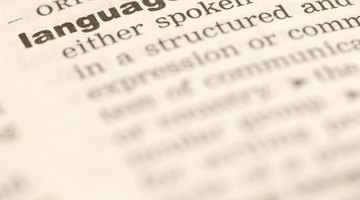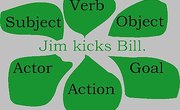The first step to understanding any new language is by first understanding how the structure of your own language works. Additionally, understanding different parts of speech in the English language can help you to write better and understand why things are the way they are. Because there are many different components to English and language in general, it helps to understand one part of speech at a time, and a good place to start is with objective pronouns.
Tip
An objective pronoun, or object pronoun, replaces a noun that is the object of a sentence.
What Is a Pronoun?
Most people know that a noun is a person, place or thing. A pronoun, on the other hand, is a subcategory of these nouns, and they are: I, you, he, she, it, we and they. Pronouns are used to substitute nouns in a sentence, especially when talking about the same noun over and over again can get repetitive.
For example, the name "John" is a noun. If you are talking about John for more than one sentence, your sentences can sound very robotic, for instance: "John is 24 years old. John likes to drink coffee in the morning before John goes to his job." The noun "John" has been used way too many times in this sentence.
Instead, you can replace the word "John" in the second sentence with pronouns and say: "John is 24 years old. He likes to drink coffee in the morning before he goes to his job." In this case, "his" would also be another pronoun – a possessive pronoun – but that's not necessary to know for this particular sentence.
What Is a Subject Pronoun?
In the previous example, "John" was the subject of the sentence, and "coffee" and "job" were the objects. Understanding the difference between subjects and objects is critical to understanding the difference between subject pronouns and object pronouns. The easiest way to understand this is that while the subject in the sentence is the noun that is doing something, the object is the noun that is having something done to it.
For example, in the sentence "Daisy eats cookies," "Daisy" would be the subject because she is the one doing the eating, while "cookies" is the object because they are the ones being eaten. The same logic applies to pronouns. If you replace "Daisy" in this sentence with "she" (the pronoun), then "she" would still be the subject. More specifically, you can say that "she" is the subject pronoun because the pronoun is serving the purpose of being the subject in the sentence.
What Is an Object Pronoun?
Once you understand subjects and subject pronouns, it's easy to understand objects and object pronouns. Since the object of the sentence is the noun having something done to it, the object pronoun would serve the same purpose, but instead of using the noun, you are using a pronoun as a substitute that serves as the object in the sentence.
For example, in the same sentence "Daisy eats cookies," "cookies" would be the object of the sentence. However, if you were to substitute the object with the pronoun "them," then the word "them" would be the object pronoun. Remember that pronouns can only be used after the subject and object have been stated at least once. Also, sometimes you'll hear the term "object pronoun" being used interchangeably with "objective pronoun" or even "direct object pronoun."
Object Pronouns Exercises
Whether you're reviewing object pronouns for yourself, or you want to teach it to someone who needs help understanding this part of speech, there are several object pronoun exercises you can utilize for help:
- Take quizzes online that ask you to identify the object pronoun in the sentence.
- Buy an English grammar workbook that has questions about object pronouns.
- Print out an object pronouns worksheet.
- Practice writing sentences using object pronouns.
- Use flash cards with various subjects, subject pronouns, verbs, objects and object pronouns written on each of them and create sentences with them.
- Do simple listening exercises and try to listen for the object pronoun in the sentence.
Related Articles
References
Resources
Writer Bio
Hana LaRock is a freelance content writer from New York, currently living in Mexico. She has spent the last 5 years traveling the world and living abroad and has lived in South Korea and Israel. Before becoming a writer, Hana worked as a teacher for several years in the U.S. and around the world. She has her teaching certification in Elementary Education and Special Education, as well as a TESOL certification. Hana spent a semester studying abroad at Tel Aviv University during her undergraduate years at the University of Hartford. She hopes to use her experience to help inform others. Please visit her website, www.hanalarockwriting.com, to learn more.











